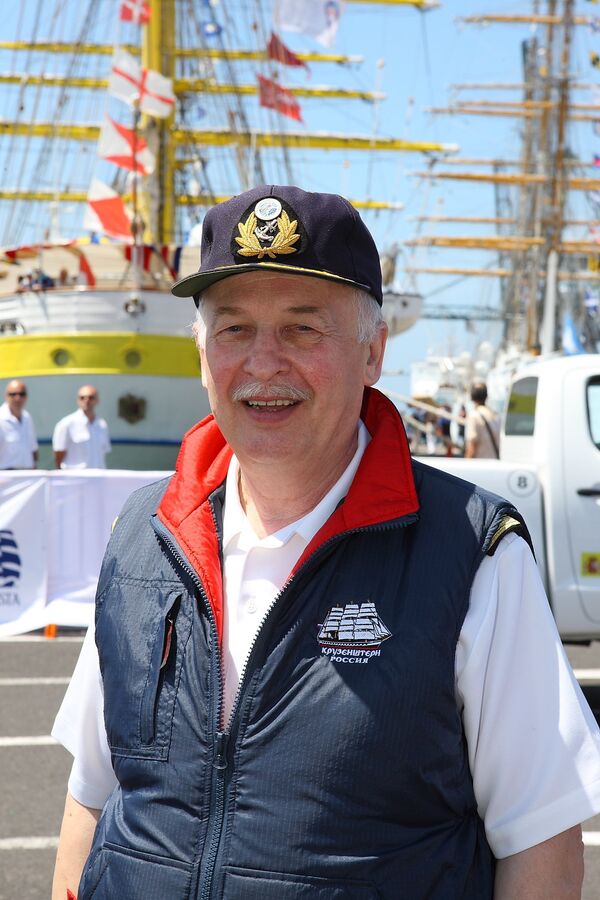In 40 years of service aboard the Kruzenshtern four-masted barque and tall ship, her captain’s mentor Gennady Kolomensky has trained several generations of sailors and has sailed thousands of nautical miles under sail. Kolomensky can spend hours talking about the Kruzenshtern and offers a professional and competent assessment of the ship’s operation. In this RIA Novosti interview, Kolomensky discusses her recently completed expedition.
Question: Mr. Kolomensky, top officials at the Baltic Fishing Fleet State Academy (BFFSA) are saying the Kruzenshtern gained unique experience on her latest voyage. Do you agree with this opinion?
Answer: I would distinguish between the experience of our tall ship’s permanent crew and that of the cadets who trained aboard her. Certainly on an expedition in high seas we are one big family, one crew, but the tasks facing the cadets and the crew are different.
Regarding the cadets, none of them had ever sailed the seven seas before, yet all trained to become Seamen Second Class. Naturally, they accumulated substantial and diverse experience. Not all cadets who have served aboard the Kruzenshtern had such varied experiences, which for these cadets included the Vancouver 2010 Olympic Winter Games.
The ship’s permanent crew merely expanded and upgraded their skills and professional prowess. They have amassed tremendous seafaring experience and can accomplish extremely difficult feats such as navigating the Panama Canal.
Q.: Why is the cadets’ experience so unique?
A.: It is not hard to explain. All you have to do is take a look at the map showing the ship’s route. It crossed several climate zones. The expedition’s final leg ended in winter.
It has always been hard to navigate tall ships, even such large ones as the Kruzenshtern, in the North Pacific during the winter. Suffice it to say that most regattas in these latitudes are usually held in spring and summer. The same is true of commercial tall ships’ cruising routes that are charted during the same seasons. Constant rigging adjustments, cold storm winds and other ordeals mean that the crew needs to work at not even 100% but 200% capacity.
Don’t forget about tough deadlines either. Each leg and each passage were planned down to the second. For instance, the ship was expected to arrive in Vancouver as scheduled, and nobody had any plans to delay the opening ceremony of the Olympic Games in order to accommodate the Kruzenshtern. Moreover, the ship had to be cleaned before calling at port, so that the crew could be proud of it while receiving visitors.
The boys proved themselves during this voyage. Not all of them will have to sail in these latitudes because those graduating from our Academy usually work in the Atlantic and Indian Oceans. However, they will be ready for anything if they ever return to this region, especially in winter. The same is true of sailing through the Panama Canal.
Q.: How useful is the practical experience cadets gain during the expedition? They are unlikely to sail aboard tall ships, and modern ships differ greatly from the Kruzenshtern in terms of their rigging and equipment.
A.: As far as rigging and equipment are concerned, I don’t want to underestimate the Kruzenshtern’s technical potential. She has state-of-the-art navigation equipment, including some unique instruments that other ships lack. Cadets have an opportunity to learn how to handle “obsolete” sails and advanced equipment.
Nor can I agree that cadets will never have to sail aboard tall ships again. The number of commercial tall ships is increasing worldwide. Former Kruzenshtern cadets are serving as captains aboard the largest tall ships. Sergei Utitsyn, a former cadet who rose to first officer, is the captain of the Royal Clipper, the world’s fourth-largest tall ship cruise liner. Vladimir Pushkaryov commands the historic Sea Cloud four-masted barque, while Yevgeny Nemerzhitsky is the captain of her sister ship, the Sea Cloud II. Mr. Nemerzhitsky who once served as the Kruzenshtern’s fourth officer even commanded her on several occasions.
Q.: Is there any noticeable difference between the Kruzenshtern’s permanent and rotating crews?
A.: There is no such division. We become one single crew after leaving Kaliningrad. Those sailing aboard tall ships perform virtually no individual tasks. All sailors work as a single team, and this greatly influences their outlook on the world. You cannot work in a slipshod manner aboard the Kruzenshtern because it is immediately apparent who the slacker is. Working conditions aboard her force young men to change their opinion of themselves and their place in life. There is a popular but very apt expression: “He went away a boy, came back a man.” For instance, a teenager who has only seen tall ships in the movies or in the textbooks has to climb a 50-meter mast and adjust the rigging in the middle of a squall somewhere in the North Pacific, while the mast top sways at 100-degree angles. Although this is something not every adult can do, the boys accomplished their objective successfully. All of them experience fear but they realize that their work is important for the ship and the entire crew.
The opinions expressed in this article are the author's alone and do not necessarily represent those of RIA Novosti.

